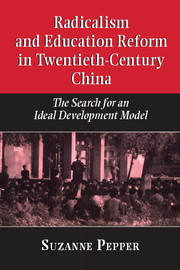Book contents
- Frontmatter
- Contents
- Acknowledgments
- 1 Educational development and the Chinese experience
- Part I The republican era: origins of radical education reform
- Part II Learning from the Soviet Union
- 7 Introducing the Soviet Union
- 8 The Soviet model for Chinese higher education
- 9 Sino-Soviet regularization and school system reform
- 10 Blooming, contending, and criticizing the Soviet model
- Part III Cultural revolution and radical education reform
- Appendix: the Hong Kong interviews
- Select bibliography
- Index
7 - Introducing the Soviet Union
Published online by Cambridge University Press: 04 August 2010
- Frontmatter
- Contents
- Acknowledgments
- 1 Educational development and the Chinese experience
- Part I The republican era: origins of radical education reform
- Part II Learning from the Soviet Union
- 7 Introducing the Soviet Union
- 8 The Soviet model for Chinese higher education
- 9 Sino-Soviet regularization and school system reform
- 10 Blooming, contending, and criticizing the Soviet model
- Part III Cultural revolution and radical education reform
- Appendix: the Hong Kong interviews
- Select bibliography
- Index
Summary
By 1949 the basic tasks were fixed and clearly defined. They entailed providing elementary schooling for everyone, higher education for the elite few, and intermediate secondary schooling – all in ways the economy could afford and society would accept. The historical foundations of the controversies surrounding these tasks were well established in China as elsewhere. The new ingredients in the early 1950s came from the Soviet Union as ally, advisor, and inspiration for socioeconomic revolution. One additional important difference between the early 1950s and the Yan'an decade was the nationwide scope of the CCP's power, which now encompassed not just an isolated rural hinterland but the cities, coastal areas, and the South as well.
Nevertheless, the pattern of development that emerged in Yan'an – regularization followed by an antithetical phase deliberately incorporating key elements from the old reformers’ critique – continued in sequence for at least 30 years thereafter. Counting the Yan'an decade, the same cycle was repeated three times, with a fourth regularization phase commencing after Mao's death in 1976.
The second cycle began in the early 1950s, when the Soviet Union replaced the West as authoritative reference point, and produced a regularization phase more rigorous than any recorded precedent. The 1958 Great Leap Forward broke out of that phase in search of a more rural-oriented “Chinese way,” with deregularization on a similarly unprecedented scale, citing among other things the mass-line lessons learned in Yan'an. The Soviet Union was dropped as an overt model but seemed to provide continuing “internal” reinforcement through a deregularization exercise of its own which occurred at the same time.
- Type
- Chapter
- Information
- Radicalism and Education Reform in 20th-Century ChinaThe Search for an Ideal Development Model, pp. 157 - 163Publisher: Cambridge University PressPrint publication year: 1996
- 1
- Cited by



